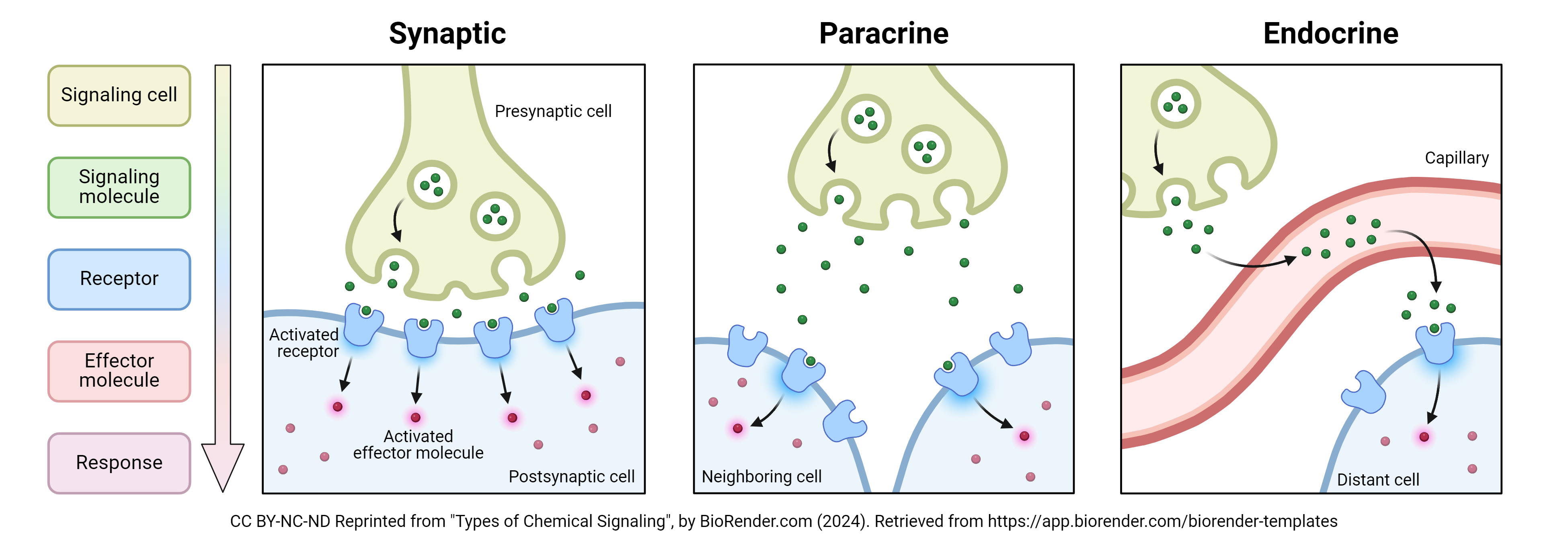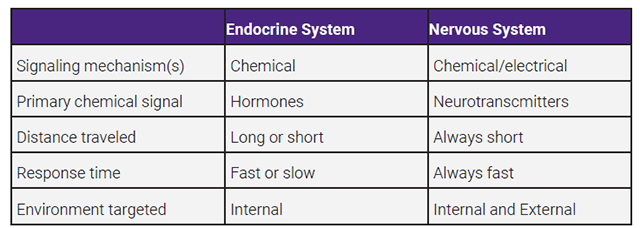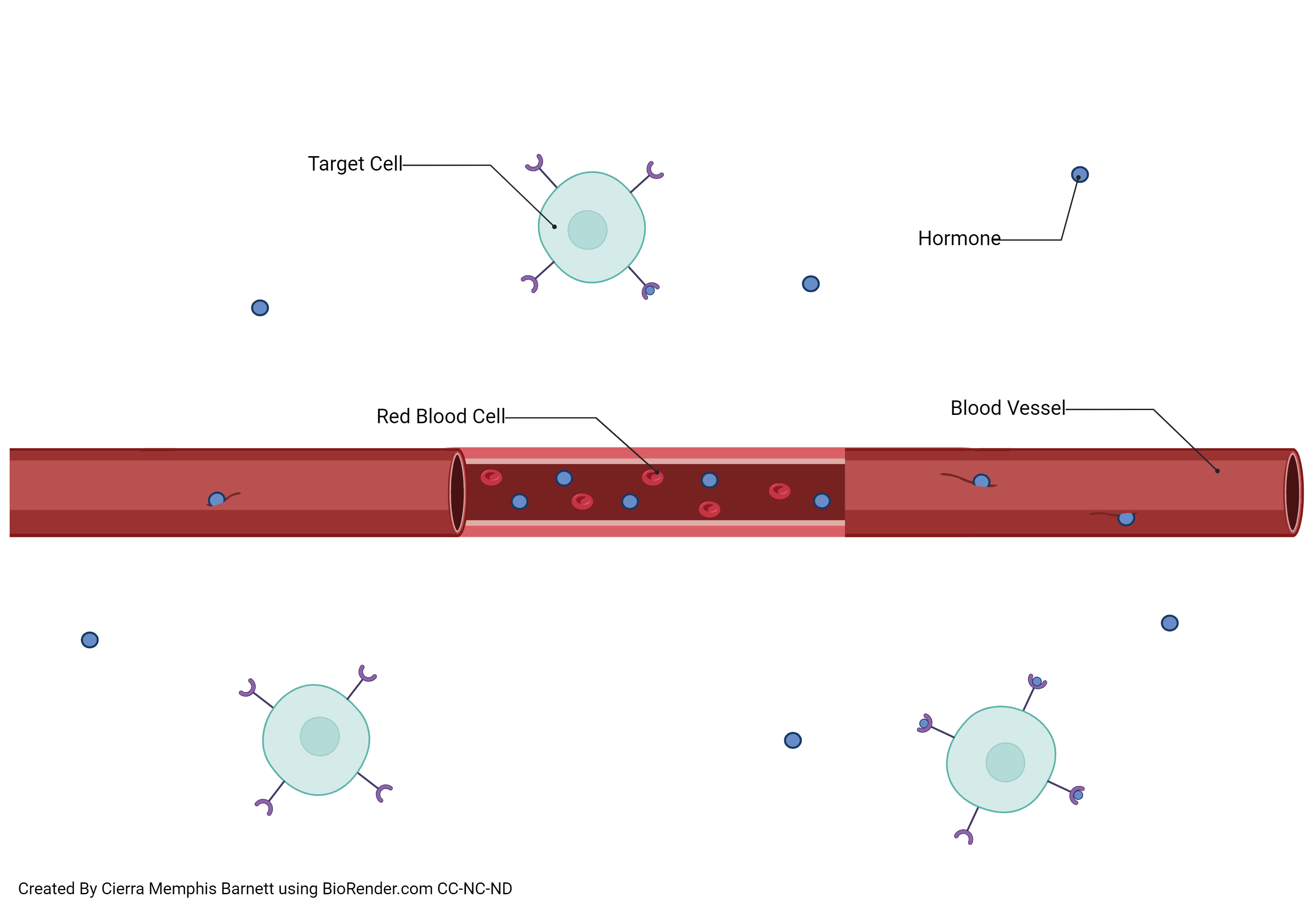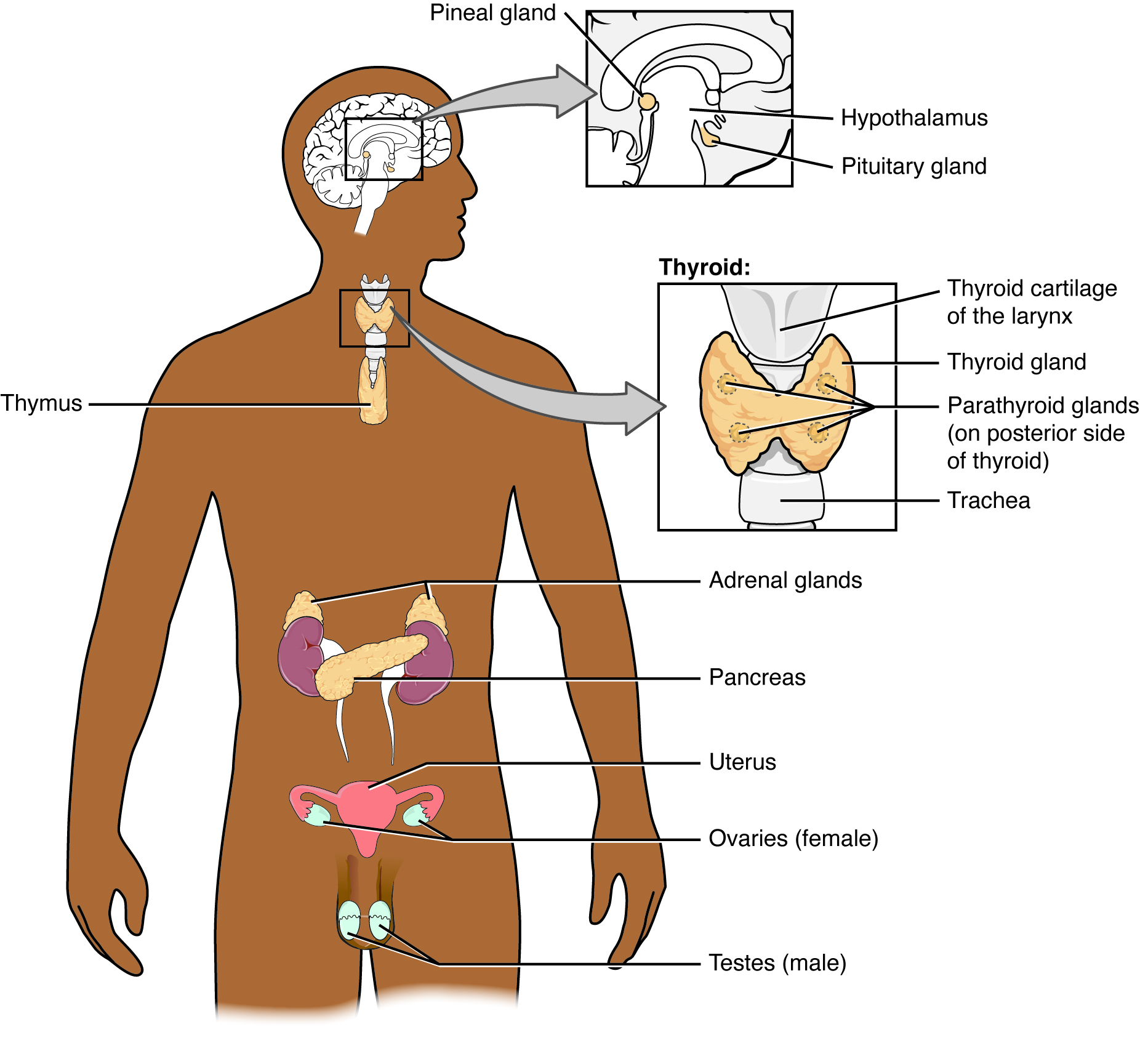Functions of the Endocrine System
Objective 1
Define the general functions of the endocrine system. Describe hormones, target cells, and describe the ability of target cells to up- or down-regulate receptors. Classify endocrine organs, those whose sole function is to secrete hormones. Compare and contrast the mechanisms of action of neurotransmitters and hormones. Explain the difference between circulating, paracrine, and autocrine hormones. Define and give examples of interactions between hormones including permissive, synergistic, and antagonistic effects.
Function and General Features of the Endocrine System
For the purpose of regulating homeostasis, the body is continually receiving, interpreting, and responding to stimuli. The two main systems of the body that are responsible for this task are the nervous and endocrine systems.
With mediator molecules, homeostatic mechanisms are strictly controlled. In the nervous system, these molecules are neurotransmitters; in the endocrine system, they are hormones.
Molecules that regulate homeostasis can be both neurotransmitters and hormones; it just depends on how they are used.

Neurotransmitters are released from neurons to act locally and quickly in response to a nerve impulse. They bind to receptors in a postsynaptic membrane near their site of release. Neurotransmitters act very quickly and have a short duration. Their effectors are usually glandular cells, various types of muscle cells, and other neurons. Hormones on the other hand can be delivered to cells throughout the body, and bind to receptors in or on the target cell. In contrast to neurotransmitters, hormones take anywhere from seconds to hours to days to begin working, and their duration tends to be much longer.

A hormone is a mediator molecule secreted from one part of the body that circulates via the body fluids to cells in another part of the body. Initially, hormones are secreted into the interstitial fluid, then typically the bloodstream, thereby having access to the entire body.
 A specific cell will respond to the hormone due to the presence of peripheral or intra-cellular receptors. Because these cells are the specific targets of the hormones, they are referred to as target cells. Hormones function to regulate: chemical composition and volume of blood, metabolism and energy balance, contraction of smooth and cardiac muscle fibers, glandular secretion, growth and development, reproduction, sleep-wake cycles, and some immune functions.
A specific cell will respond to the hormone due to the presence of peripheral or intra-cellular receptors. Because these cells are the specific targets of the hormones, they are referred to as target cells. Hormones function to regulate: chemical composition and volume of blood, metabolism and energy balance, contraction of smooth and cardiac muscle fibers, glandular secretion, growth and development, reproduction, sleep-wake cycles, and some immune functions.

Endocrine signaling can occur in several ways. Most hormones are secreted into the interstitial fluid and then into the blood, thereby giving them access to the entire body, they are referred to as circulating hormones. In paracrine hormone signaling, hormones diffuse from their source and act locally, causing changes in nearby cells. In autocrine hormone signaling, cells have receptors for the hormones they secrete, so they can stimulate themselves, or (more often) turn off their secretion after a quick burst.
Hormones are very powerful molecules. To illustrate this, a patient’s blood protein level is measured in g/dL, glucose in mg/dL, but hormones are often measured in μg/dL, ng/dL, and even pg/dL. So, hormones are not present in large amounts, but their effects are quite dramatic.

The endocrine system is made up of organs that, together with the nervous system, coordinate vital body functions in an effort to maintain homeostasis. The organs listed at right are exclusively endocrine (their sole purpose is to secrete hormones).
Many other organs secrete hormones but this is not their sole function. These organs include the hypothalamus, thymus, pancreas, heart, kidneys, stomach, small intestine, liver, skin, and the gonads. Even adipose tissue produces hormones.
Hormone receptors are simply cellular proteins. Like any other protein, they can be synthesized, broken down, and synthesized again.
Target cells can dictate the number of receptors available to bind hormones. If a cell wants to increase its responsiveness to a hormone, it can increase the number of receptors. This is referred to as up-regulation. The opposite is true if a cell wants to decrease its response to excessive hormone. The cell can decrease the number of receptors, a process called down-regulation.
Hormones can also interact with each other. In a permissive effect (think of one hormone getting permission from another), one hormone is required for another hormone to exert its full effects on the target cell. For example, thyroid hormone increases the number of receptors for epinephrine. This increases epinephrine’s effect on the cell. Epinephrine’s effect would be weak without the presence of thyroid hormone. If two hormones dictate similar actions and they work together to create an even more powerful result than they would individually, this is a synergistic effect. The synergistic effects of follicle-stimulating hormone and testosterone in males is an example. If only one of these hormones is present, a male produces few or no sperm. When both are present, an average male may produce 300,000 sperm/minute. Because most hormones work as part of a negative-feedback system, there are other hormones that oppose their actions. If one hormone opposes the action of another, this is termed an antagonistic effect. Insulin and glucagon are antagonistic hormones. Insulin acts to lower blood glucose levels; glucagon acts to raise blood glucose levels.
Here is a summary that may help:
- Two hormones required for a desired action – permissive effect
- Two hormones present to create a stronger response – synergistic effect
- Two hormones opposing each other – antagonistic effect
Media Attributions
- U14-001a Types of Chemical Signaling 3300px © BioRender is licensed under a CC BY-NC-ND (Attribution NonCommercial NoDerivatives) license
- U14-004 Endocrine vs Nervous System Table © Newton, Kathy is licensed under a CC BY-SA (Attribution ShareAlike) license
- U14-002 Hormones and Target Cells © Barnett, Cierra Memphis is licensed under a CC BY-NC-ND (Attribution NonCommercial NoDerivatives) license
- U14-005 How Hormones Work © Barnett, Cierra Memphis is licensed under a CC BY-NC-ND (Attribution NonCommercial NoDerivatives) license
- U14-003 Endocrine System © Betts, J. Gordon; Young, Kelly A.; Wise, James A.; Johnson, Eddie; Poe, Brandon; Kruse, Dean H. Korol, Oksana; Johnson, Jody E.; Womble, Mark & DeSaix, Peter is licensed under a CC BY (Attribution) license

